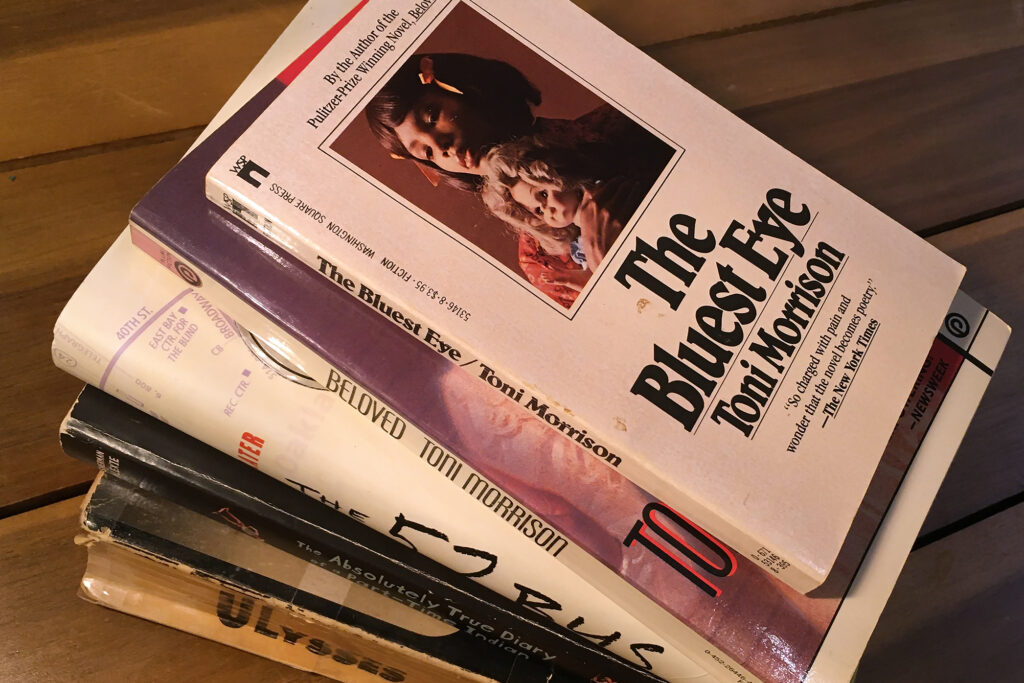Toni Morrison’s “The Bluest Eye” was among more than two dozen books removed last month from a school library at Goddard, Kansas, following a challenge by a parent. The books have since been returned to the shelves. Photo by Max McCoy/Kansas Reflector.
Recent surveys show that 62% of Republicans have a “very unfavorable” view of Democrats, while 54% of Democrats feel the same about Republicans. These percentages have tripled since 1994. As politicians fan the flames of these divisions, many ordinary Americans are now incapable of speaking with their ideological opponents.
The best place to break this trend and enable future generations to better understand one another is in the social studies classroom, where students have the opportunity to confront different viewpoints and constructively disagree with one another by grappling with controversial topics, such as systemic racism. Unless Minnesota takes legislative action to protect that sacred space, it too will fall victim to our nation’s polarizing culture wars, and students will fail to gain those valuable skills.
As other states continue to impose sweeping restrictions limiting what materials can be taught in the social studies classroom, Minnesota should codify our educators’ right to assign materials representing diverse perspectives and ideas. In May, Gov. Tim Walz signed the “ban on book bans,” a law that prohibits the banning of books from public libraries based on the viewpoints or ideas they convey.
This is a welcome step, but merely a first step.
Minnesota should now seek to pass legislation that would extend the prohibition on book bans to materials in the classroom. If we trust our librarians to make sound decisions regarding the books they put on their shelves, so too should we trust our educators to decide what material they assign their students.
Per the Minnesota Department of Education, the K-12 social studies experience should create “engaged members of society” who can apply “critical thinking, inquiry, and literacy.” Absent legislation, two movements with entirely different agendas pose significant challenges to this goal.
On the one hand, conservative parenting groups have sought to outright ban curriculum focused on systemic racism. They claim that curriculum such as “The 1619 Project” — which centers slavery and the Black experience in the history of the United States and has already been banned from Florida classrooms — effectively indoctrinates students to see America as an inherently racist country.
This claim is based on the false assumption that students must take as true any claim or argument that they are assigned. In fact, much of the social studies curriculum focuses on building students’ abilities to analyze sources and weigh the strengths and weaknesses of various arguments. In a national poll, 97% of social studies teachers ranked political neutrality and critical thinking as their highest values.
Accordingly, where “The 1619 Project” is being taught as the only acceptable interpretation of American history, that is a teacher-specific issue that should be addressed locally. But it cannot be addressed by simply banning the material itself.
Conversely, efforts on the left to prevent students from reading texts that contain racist language or racial epithets — such as “To Kill A Mockingbird” and “Adventures of Huckleberry Finn” — are also misguided. Here, the claim is that the psychological harm students of color endure by reading or hearing those works’ racially charged language supersedes any pedagogical value the stories may offer.
While teachers must be cautious about how to present texts with racially charged language, avoiding these texts entirely does our students a massive disservice.
Jeff Snyder, a professor at Carleton College, told me during a phone interview that you can’t properly teach history without engaging with texts that contain racist terms: “If you’re learning about the Jim Crow south, you’re going to hear speeches from politicians that are very disturbing — but that captures the anti-Black sentiment that was very widespread and vicious.” Snyder also says that if you cannot “read or engage with any racist content, you cannot understand racism.”
Those conversations and lessons, of course, don’t happen in a vacuum, and they certainly don’t happen until teachers have created a classroom culture of mutual respect. Teachers can also “explain their rationale for reading texts with racist language and create ground rules for how to have difficult discussions so that all students can meaningfully engage with challenging material,” Snyder told me.
It is in this safe and structured environment that students can best learn how to grapple with difficult topics, hear their classmates’ perspectives, and learn how to respectfully disagree with one another.
To foster a citizenry that can reverse the trend of political polarization, meaningfully analyze our nation’s history, and engage with one another, we must protect our teachers’ right to assign materials with diverse viewpoints and perspectives — and our students’ right to engage with those materials.
Building on the recently codified “ban on book bans” and passing a corollary bill for social studies classrooms represents Minnesota’s best opportunity to do so.

